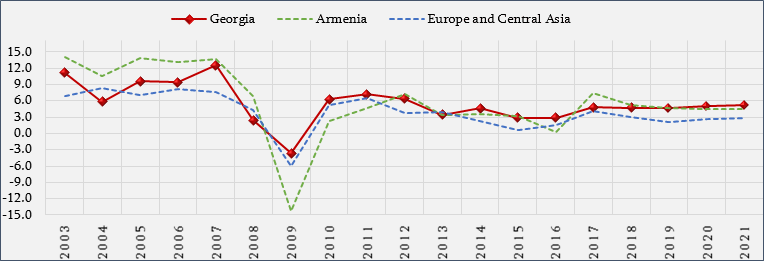Resume: Since 2013 up to the present day, Armenia’s economic growth exceeded Georgia’s three times – in 2015 (by 0.3 of a percentage point), in 2017 (by 2.7 percentage points) and in 2018 (by 0.5 of a percentage point). In addition, there were three other cases when Georgia had a higher economic growth as compared to Armenia – in 2013 (by 0.1 of a percentage point), in 2014 (by 1 percentage point) and in 2016 (by 2.6 percentage points). In total, however, Georgia’s economy increased by 25.7% as compared to 2012 whilst Armenia’s growth is slightly lower at 25.1%. Therefore, it would be more appropriate to note that Georgia and Armenia have more or less equal economic growth rates or that Georgia’s performance is marginally better. Referring to data from certain years and using the information to make claims that Armenia has better results in a given component is not accurate.
In 2013-2018, Georgia’s economic growth rate was close to 5% only in 2017 and 2018 at 4.8% and 4.7%, respectively. Taking this into consideration, it is appropriate to point out that under the Georgian Dream’s rule, Georgia’s economic growth has never reached the 5% threshold which itself is low for a developing country. In the last two years, Armenia’s GDP growth was 7.5% in 2017 and 5.2% in 2018. However, of additional note is that Armenia’s economy practically did not increase (0.2%) in 2016 which provided favourable starting conditions for a relatively high economic growth in the next year.
Analysis
United National Movement faction Chair, Roman Gotsiridze, during a committee hearing, spoke about economic growth and compared Georgia’s performance to that of Armenia’s. As stated by Mr Gotsiridze: “In 2018, Armenia’s GDP increased by 5.2% and Georgia’s increased by 4.7%. In 2017, Armenia’s economy increased by 7.5% and Georgia’s economy increased by 4.8%. In 2016, Armenia’s GDP increased by 3.5% and Georgia’s GDP increased by 3.4%. In 2015, Armenia had a 3% economic growth rate whilst Georgia had 2.9%. Only twice did Georgia’s GDP growth exceed that of Armenia’s. In the last six years, there was not a single instance in Georgia when the GDP growth reached 5%.”
Since 2013 up to the present day, Armenia’s economic growth exceeded Georgia’s three times – in 2015 (by 0.3 of a percentage point), in 2017 (by 2.7 percentage points) and in 2018 (by 0.5 of a percentage point). Similarly, there were three periods when Georgia had higher economic growth as compared to Armenia – in 2013 (by 0.1 of a percentage point), in 2014 (by 1 percentage point) and in 2016 (by 2.6 percentage points). As illustrated by Table 1, Georgia’s economic growth rate did not exceed the 5% threshold in the last six years. Of further note is that a 5% economic growth rate for a developing country is quite a low figure. Therefore, referring to an insufficient economic growth rate is justified. In 2013-2018, the highest economic growth rate was registered in 2017 whilst the figure for 2018 was 4.7%. In the same years, Armenia’s economic growth rates were 7.5% and 5.2%, respectively. In 2016, Georgia’s economic growth rate was 2.8% whilst Armenia’s was just 0.2%. In 2015, Georgia’s economic growth rate lagged behind that of Armenia’s. In 2015, Georgia’s economy increased by 2.9% and Armenia’s economy increased by 3.2%. In 2013-2014, similar to 2016, Georgia’s economic growth figures exceeded Armenia’s economic growth figures. In particular, Georgia’s economic growth rate was 4.6% in 2014 and Armenia’s economic growth rate was 3.6%. In 2013, Georgia’s economic growth rate was 3.4% and Armenia’s was 3.3%. Therefore, in the course of the last six years, Georgia’s annual economic growth rate exceeded that of Armenia’s in three periods instead of two.
Table 1: Economic Growth (%)
|
Country |
2003 |
2004 |
2005 |
2006 |
2007 |
2008 |
2009 |
2010 |
2011 |
2012 |
2013 |
2014 |
2015 |
2016 |
2017 |
2018 |
|
Georgia |
11.2 |
5.8 |
9.6 |
9.4 |
12.6 |
2.4 |
-3.7 |
6.2 |
7.2 |
6.4 |
3.4 |
4.6 |
2.9 |
2.8 |
4.8 |
4.7 |
|
Armenia |
14.0 |
10.5 |
13.9 |
13.2 |
13.7 |
6.9 |
-14.2 |
2.2 |
4.7 |
7.2 |
3.3 |
3.6 |
3.2 |
0.2 |
7.5 |
5.2 |
|
(EMDEs) |
6.8 |
8.3 |
7.1 |
8.1 |
7.7 |
4.4 |
-6.0 |
5.2 |
6.6 |
3.7 |
4.0 |
2.2 |
0.6 |
1.5 |
4.1 |
3.1 |
Source: GeoStat, ArmStat, IMF, World Bank
Of note is that Roman Gotsiridze compares Georgia’s economic growth rate to the same indicators in Armenia in a six-year period. In total, it overlooks which economy increased faster (which should be the main subject of interest). In 2013-2018, Georgia’s economy increased more than that of Armenia’s which would be 25.7% for Georgia and 25.1% for Armenia. In addition, in this six-year period, Georgia’s annual average GDP growth rate is 3.9% and Armenia’s is 3.8%. Therefore, Georgia’s economy increased faster in the last six years as compared to Armenia’s. Although, of note is that this figure does not significantly exceed that of Armenia’s. However, in the case of Armenia, the growth rate mean deviation is higher both for the highest and lowest values whilst Georgia’s growth is relatively stable and less prone to volatility.
On the one hand, both countries have close trade relations. Of Georgia’s total exports in 2013-2018, Armenia annually takes an average of 8.7% whilst Armenia’s share in Georgia’s total imports in the same period is an average of 2.9%. Therefore, Armenia is one of Georgia’s biggest trade partners and, consequently, the macroeconomic environment directly affects Georgia’s GDP growth. On the other hand, the economic growth of both countries is largely stipulated by the regional situation. As illustrated by Graph 1, both the economic growth figures for both countries have similar growth trends as those in Europe and Central Asia (without high-income countries).
Graph 1: Economic Growth (%)

Source: Geostat, Armstat, IMF, World Bank
Of further note is Armenia’s economic growth rate in 2017-2018. The high growth figures registered in those years, on the one hand, were stipulated by a significant improvement of regional economic growth as compared to the previous year and, on the other hand, they were stipulated by the low 0.2% economic growth rate registered in 2016 which provided “better” starting positions for the high economic growth in the following periods. At the same time, Georgia’s economic growth rate was 2.8% in 2016 when regional growth was only 1.5%. Therefore, Georgia had different starting conditions in terms of economic growth as compared to Armenia in 2017 and 2018.








